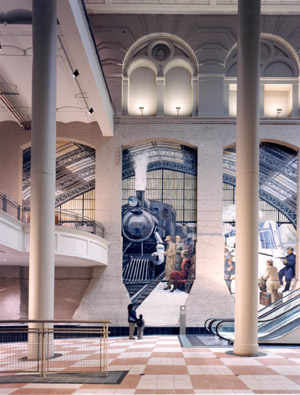
Comments
by Arthur W. Jones, A.I.A.
Design Principal
Bower Lewis Thrower Architects
There are some buildings that simply refuse to die and therefore projects that, whatever their complications, have to be done. The Reading Terminal Head House is one of those. When, in the late 1970s, the redevelopment of Market Street East was first planned and the Gallery retail mall conceived, planners assumed that the five famous department stores of east Market Street would continue to thrive as anchors of the new development. Schematic plans showed new construction extending without a break from 8th to 13th Streets, and the old Reading station sacrificed to progress. Now, 25 years later, two of the department stores have been demolished, and the head house has become the glorious anchor of Market Street East and its link to the new Pennsylvania Convention Center.
Urban redevelopment, and particularly redevelopment involving historic preservation, has everything to do with being in the right place at the right time. Before the convention center was conceived, the famous shed of the station presented a dilemma for its owner—the real-estate arm of a defunct railroad, the Reading Company. It was studied, then rejected, as a shopping mall. When the convention center plans reached fruition, and the future of the shed was assured, the Reading Company believed that the terminal's head house had a future as a privately developed office building. Full design and documentation was commissioned for this use. The investors did not foresee the severe downturn in real estate development that would block their efforts for nearly a decade.
After 1993, with the convention center and its hotel serving as a new destination for visitors, the boarded-up and decaying head house became a public embarrassment. Pressure from the hospitality industry caused the City to purchase it, but without any definitive plan for its use—except wanting to make the ground floor a ceremonial entrance for the convention center. It was the creativity and persistence of the City's redevelopment authority that brought Marriott to the project and made possible a resolution—one that looks like something that was always meant to be there.
Although
the building is classified as a National Historic Landmark, its restoration
does not follow strict preservation criteria in every detail. Its new,
rich finishes are much finer than those of its former life. Its floor
levels have been opened, giving a dramatic, vertical entrance up the escalators
to the winter garden. Its walls are enlivened by colorful new elements,
including murals of famous Reading Company trains. To all the members
of the design-and-construction teams, the head house became a 15-year
commitment to quality—a gift to and from the City of Philadelphia.
![]()
![]()

TOP • NEXT PAGE • LIST OF TOUR STOPS • MAP • P.N.R.T. HOME • YOUR COMMENTS